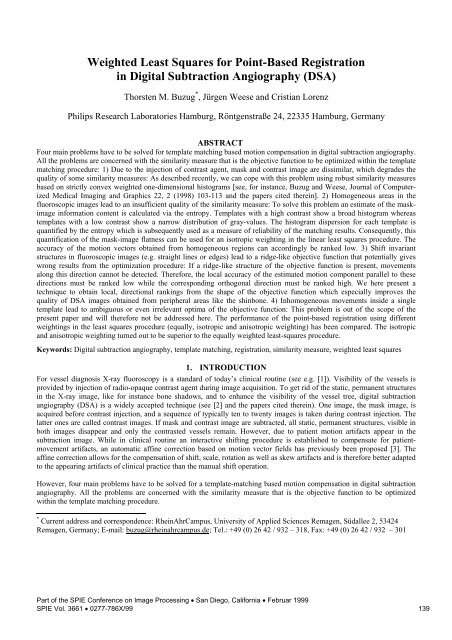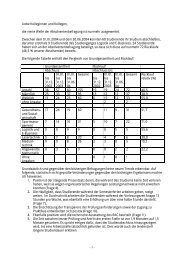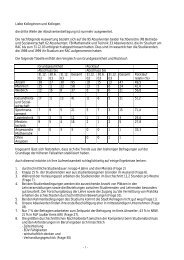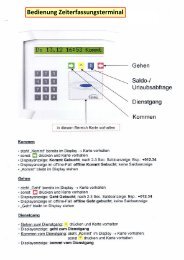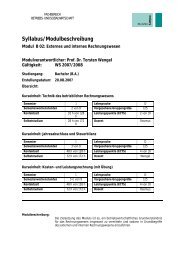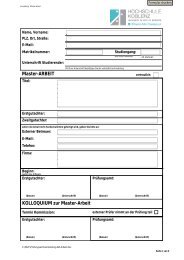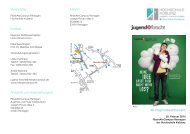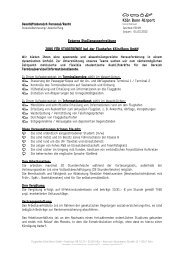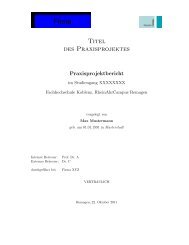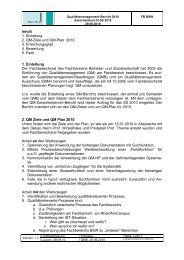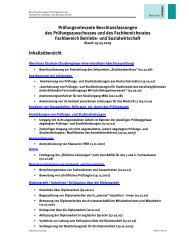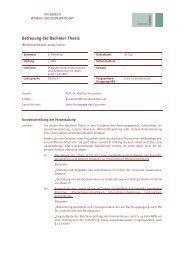Weighted Least Squares for Point-Based ... - RheinAhrCampus
Weighted Least Squares for Point-Based ... - RheinAhrCampus
Weighted Least Squares for Point-Based ... - RheinAhrCampus
You also want an ePaper? Increase the reach of your titles
YUMPU automatically turns print PDFs into web optimized ePapers that Google loves.
<strong>Weighted</strong> <strong>Least</strong> <strong>Squares</strong> <strong>for</strong> <strong>Point</strong>-<strong>Based</strong> Registration<br />
in Digital Subtraction Angiography (DSA)<br />
Thorsten M. Buzug * , Jürgen Weese and Cristian Lorenz<br />
Philips Research Laboratories Hamburg, Röntgenstraße 24, 22335 Hamburg, Germany<br />
ABSTRACT<br />
Four main problems have to be solved <strong>for</strong> template matching based motion compensation in digital subtraction angiography.<br />
All the problems are concerned with the similarity measure that is the objective function to be optimized within the template<br />
matching procedure: 1) Due to the injection of contrast agent, mask and contrast image are dissimilar, which degrades the<br />
quality of some similarity measures: As described recently, we can cope with this problem using robust similarity measures<br />
based on strictly convex weighted one-dimensional histograms [see, <strong>for</strong> instance, Buzug and Weese, Journal of Computerized<br />
Medical Imaging and Graphics 22, 2 (1998) 103-113 and the papers cited therein]. 2) Homogeneous areas in the<br />
fluoroscopic images lead to an insufficient quality of the similarity measure: To solve this problem an estimate of the maskimage<br />
in<strong>for</strong>mation content is calculated via the entropy. Templates with a high contrast show a broad histogram whereas<br />
templates with a low contrast show a narrow distribution of gray-values. The histogram dispersion <strong>for</strong> each template is<br />
quantified by the entropy which is subsequently used as a measure of reliability of the matching results. Consequently, this<br />
quantification of the mask-image flatness can be used <strong>for</strong> an isotropic weighting in the linear least squares procedure. The<br />
accuracy of the motion vectors obtained from homogeneous regions can accordingly be ranked low. 3) Shift invariant<br />
structures in fluoroscopic images (e.g. straight lines or edges) lead to a ridge-like objective function that potentially gives<br />
wrong results from the optimization procedure: If a ridge-like structure of the objective function is present, movements<br />
along this direction cannot be detected. There<strong>for</strong>e, the local accuracy of the estimated motion component parallel to these<br />
directions must be ranked low while the corresponding orthogonal direction must be ranked high. We here present a<br />
technique to obtain local, directional rankings from the shape of the objective function which especially improves the<br />
quality of DSA images obtained from peripheral areas like the shinbone. 4) Inhomogeneous movements inside a single<br />
template lead to ambiguous or even irrelevant optima of the objective function: This problem is out of the scope of the<br />
present paper and will there<strong>for</strong>e not be addressed here. The per<strong>for</strong>mance of the point-based registration using different<br />
weightings in the least squares procedure (equally, isotropic and anisotropic weighting) has been compared. The isotropic<br />
and anisotropic weighting turned out to be superior to the equally weighted least-squares procedure.<br />
Keywords: Digital subtraction angiography, template matching, registration, similarity measure, weighted least squares<br />
1. INTRODUCTION<br />
For vessel diagnosis X-ray fluoroscopy is a standard of today’s clinical routine (see e.g. [1]). Visibility of the vessels is<br />
provided by injection of radio-opaque contrast agent during image acquisition. To get rid of the static, permanent structures<br />
in the X-ray image, like <strong>for</strong> instance bone shadows, and to enhance the visibility of the vessel tree, digital subtraction<br />
angiography (DSA) is a widely accepted technique (see [2] and the papers cited therein). One image, the mask image, is<br />
acquired be<strong>for</strong>e contrast injection, and a sequence of typically ten to twenty images is taken during contrast injection. The<br />
latter ones are called contrast images. If mask and contrast image are subtracted, all static, permanent structures, visible in<br />
both images disappear and only the contrasted vessels remain. However, due to patient motion artifacts appear in the<br />
subtraction image. While in clinical routine an interactive shifting procedure is established to compensate <strong>for</strong> patientmovement<br />
artifacts, an automatic affine correction based on motion vector fields has previously been proposed [3]. The<br />
affine correction allows <strong>for</strong> the compensation of shift, scale, rotation as well as skew artifacts and is there<strong>for</strong>e better adapted<br />
to the appearing artifacts of clinical practice than the manual shift operation.<br />
However, four main problems have to be solved <strong>for</strong> a template-matching based motion compensation in digital subtraction<br />
angiography. All the problems are concerned with the similarity measure that is the objective function to be optimized<br />
within the template matching procedure.<br />
* Current address and correspondence: <strong>RheinAhrCampus</strong>, University of Applied Sciences Remagen, Südallee 2, 53424<br />
Remagen, Germany; E-mail: buzug@rheinahrcampus.de; Tel.: +49 (0) 26 42 / 932 – 318, Fax: +49 (0) 26 42 / 932 – 301<br />
Part of the SPIE Conference on Image Processing • San Diego, Cali<strong>for</strong>nia • Februar 1999<br />
SPIE Vol. 3661 • 0277-786X/99 139
140<br />
1. Due to the injection of contrast agent, mask and contrast image are dissimilar, which degrades the quality of some<br />
similarity measures.<br />
2. Homogeneous areas in the fluoroscopic images lead to an insufficient quality of the similarity measure.<br />
3. Shift invariant structures in the fluoroscopic images (e.g. straight lines or edges) lead to a ridge-like objective function<br />
(similarity measure) that potentially gives wrong results from the optimization procedure.<br />
4. Inhomogeneous movements inside a single template lead to ambiguous or even irrelevant optima of the objective<br />
function (similarity measure).<br />
The latter problem addresses a dilemma of DSA. The patient motion that induces the distortions are inherently 3dimensional,<br />
whereas the images to be compared are 2-dimensional. This may violate topology of the 2-dimensional<br />
mapping between mask and contrast image in the sense that border points and inner points of a projected object need not<br />
remain border and inner points after trans<strong>for</strong>mation. Template-matching procedures cannot cope with such a problem. Even<br />
if two distinct homogeneous movements are detectable by clearly separable maxima of the energy similarity measure,<br />
un<strong>for</strong>tunately, the spatial in<strong>for</strong>mation is lost, and there<strong>for</strong>e, it is not known which maximum in the measure corresponds to<br />
which pixel inside the template. Besides this ambiguity, in real images the patient movements are often not homogeneous<br />
such that no clear separation of maxima can be found. The authors do not expect that this problem can be solved on the<br />
basis of a single projection image pair to an extent that all motion artifacts disappear in subtraction images.<br />
The crucial point <strong>for</strong> the solution of the first problem is the choice of an appropriate similarity measure [4-9], because mask<br />
and contrast image are inherently dissimilar by injection of contrast agent. Recently, similarity measures have been introduced,<br />
obtained from weighted one-dimensional histograms that are optimally adapted to the dissimilarities of DSA [10,11].<br />
Such measures are defined in a 3-step procedure that consists in: (i) subtraction of images inside the template, (ii)<br />
calculation of gray-value histogram of the difference image and normalization of the histogram according to Σpk=1, where<br />
pk is the fraction of pixels with gray-value gk. The fraction of pixels depends on the shift parameters r and s: pk=pk(r,s), and<br />
(iii) evaluation of similarity measure M(r,s)=Σh(pk), using an appropriately defined strictly convex weighting function h(p).<br />
It has been shown that the energy similarity measure - the sum of the squared histogram values, i.e. h(pk)=pk 2 - turned out to<br />
be the most suitable measure <strong>for</strong> template matching and is consequently used in this paper. The histogram-based similarity<br />
measures are motivated by the observation that <strong>for</strong> optimal registration of mask and contrast image the difference image<br />
shows low contrast variation in the area of the template, whereas in the case of misregistration the contrast variation is<br />
larger. The situation corresponding to a perfect registration, i.e. a very peaky histogram, must have the maximum distance<br />
from the worst case, i.e. an equally distributed histogram. That distance is evaluated by the similarity measure.<br />
In the present report a solution is presented <strong>for</strong> the second and third problem mentioned above. In section 2 an isotropic<br />
weighting based on an entropy measure is presented to account <strong>for</strong> the reliability of a single template match. In section 3 it<br />
is shown how the parameters of local ellipses, i.e. the principal axes, are obtained from the energy similarity measure and<br />
how these parameters can be interpreted as uncertainties within the least squares approximation of an affine trans<strong>for</strong>mation<br />
used <strong>for</strong> patient motion correction. In section 4 experimental results are presented and the isotropic entropy-based weights<br />
are compared to the ellipses obtained <strong>for</strong>m the energy similarity measure. In section 5 the conclusions are summarized.<br />
2. ISOTROPIC WEIGHTINGS BASED ON THE ENTROPY MEASURE<br />
To solve the second problem, i.e. homogeneous areas in the fluoroscopic images lead to an insufficient quality of the<br />
similarity measure, a 2-step procedure is proposed. In the first step we exclude templates that are expected to give incorrect<br />
results: Due to the well known fact from signal-processing theory that <strong>for</strong> matched filters the so-called correlation gain<br />
depends on the product of template size and signal bandwidth [12], only those templates should be incorporated in our<br />
algorithm which have sufficient contrast variation.<br />
We have suggested an exclusion technique [13] using an estimate of the mask-image contrast variation calculated via the<br />
entropy h = -Σ pg log pg, where pg is the fraction of pixels with gray-value g and the sum runs from 0 to gmax, the maximum<br />
gray-value of the mask image. Templates with a high contrast show a broad histogram whereas templates with a low<br />
contrast show a narrow distribution of gray-values. There<strong>for</strong>e, only those templates having an entropy that exceeds a certain<br />
threshold are taken into account. In the second step it is utilized that the entropy values <strong>for</strong> the templates are estimates <strong>for</strong><br />
the respective bandwidth and lead to an in<strong>for</strong>mation about the reliability of the matching results. There<strong>for</strong>e, we have<br />
proposed to use this in<strong>for</strong>mation about the flatness of the mask image <strong>for</strong> a entropy-based weighting in the linear least<br />
squares procedure. The accuracy of the motion vectors obtained from homogeneous regions can then accordingly be ranked<br />
low.
It is exemplarily shown here how this works <strong>for</strong> the approximation of an affine motion-correction mapping. A set of<br />
homologous landmarks, i.e. the template centers, resulting from the template matching is straight<strong>for</strong>wardly used to estimate<br />
the parameters of an appropriate trans<strong>for</strong>mation f := (fx,fy) relating the points of the mask image p := ( x, y ) to the<br />
corresponding points in the contrast image p’ := ( x', y ') inside the region-of-interest:<br />
( x y )<br />
( x', y') → ( x, y) = f ( x', y'), f ( x', y')<br />
. (1)<br />
The affine correction can be written as<br />
x = a11 + a12 x'+ a13y' y = a + a x'+ a y'<br />
21 22 23<br />
As there are generally far more than three homologous landmarks, this is an overdetermined problem. As usual the merit<br />
function<br />
N ⎛ p 2<br />
i − f( p'<br />
i ) ⎞<br />
χ = ∑ ⎜ ⎟<br />
i = 1 ⎝ σ ⎠<br />
i<br />
2<br />
must be minimized to find the best parameters <strong>for</strong> the trans<strong>for</strong>mation. N is the number of homologous points and the value<br />
σi is the standard deviation <strong>for</strong> the i th homologous data-point pair. A singular value decomposition (SVD) is employed to<br />
produce a solution that is the best result in the least-squares sense [14]. We can write eq. (3) as<br />
2<br />
χ 2<br />
= p−Aa , (4)<br />
where A is the weighted design matrix, i.e.<br />
⎛ 1/<br />
σ1 x' 1/ σ1 y'<br />
1/ σ1<br />
⎞<br />
⎛ x1 / σ1 y1<br />
/ σ1<br />
⎞ ⎜<br />
⎟<br />
⎜<br />
⎟ σ σ σ<br />
⎜ σ σ ⎜ 1/<br />
2 x' 2/ 2 y'<br />
2/ 2<br />
x<br />
⎟<br />
⎟<br />
⎛<br />
2 / 2 y2<br />
/ 2 ⎜<br />
⎟<br />
a a<br />
. . . ⎜<br />
2<br />
χ = ⎜ . . ⎟ − ⎜<br />
⎟ ⎜a<br />
a<br />
⎜<br />
⎟ ⎜ . . . ⎟ ⎜<br />
⎜ . . ⎟<br />
⎜<br />
⎟<br />
⎜<br />
⎟ ⎝a<br />
a<br />
. . .<br />
⎝ x σ y σ ⎠ ⎜<br />
⎟<br />
N / N N / N<br />
⎝1/<br />
σ x' / σ y'<br />
/ σ ⎠<br />
N N N N N<br />
11 21<br />
12 22<br />
13 23<br />
The values <strong>for</strong> the standard deviations are often not known and hence set to σi=1. Un<strong>for</strong>tunately, the set of homologous<br />
landmarks is always error prone. The template matching procedure yields estimates of the motion vectors that are expected<br />
to be inaccurate in areas where the contrast variation of the mask image is low. Additionally, even outliers may occur in<br />
those regions as demonstrated above. There<strong>for</strong>e, it is of great importance to obtain estimates <strong>for</strong> the ‘measurement error’ or<br />
reliability of the motion vector field. These estimates are given by the isotropic weights obtained from entropy values <strong>for</strong> the<br />
mask image templates.<br />
Let M be the number of templates T’={tj} <strong>for</strong> j=1,...,M that fit the user-defined region-of-interest. Each template tj is<br />
associated with an entropy value hj. The set of templates is sorted with respect to the set H’={hj} <strong>for</strong> j=1,...,M and a predefined<br />
percentage (N/M*100) of templates with lowest entropy is discarded. The remaining sets of templates and associated<br />
entropies are re-indexed such that T’⊇T={ti} with H’⊇H={hi} <strong>for</strong> i=1,...,N and N≤M. The set of entropies is normalized<br />
according to<br />
w<br />
i<br />
=<br />
N<br />
∑<br />
i = 1<br />
hi−min { hk}<br />
k= 1,...,<br />
N , (6)<br />
⎛⎜<br />
⎝ hi ⎞<br />
− min { h ⎟<br />
k } ⎠<br />
k= 1,...,<br />
N<br />
and can be interpreted as a set W={wi} with i=1,...,N of reliabilities <strong>for</strong> the motion vectors. The weights must be understood<br />
as estimates <strong>for</strong> the reciprocal standard deviations. Figure 1 illustrates two examples <strong>for</strong> weights associated to the selected<br />
landmarks (or control points) inside a rectangular region-of-interest. Figure 1a shows an abdominal fluoroscopy and fig. 1b<br />
a shinbone fluoroscopy. 20 percent of templates with lowest entropy are discarded in both images.<br />
⎞<br />
⎟<br />
⎟<br />
⎟<br />
⎠<br />
2<br />
(2)<br />
(3)<br />
(5)<br />
141
142<br />
Fig. 1: Mask images of the abdominal fluoroscopy (a) and shinbone fluoroscopy (b). Visualization of reliabilities of the motion vectors.<br />
The radii of the circles can be used as weighting factors in the linear least squares procedure.<br />
3. ERROR ELLIPSES FROM THE ENERGY SIMILARITY MEASURE<br />
Due to shift invariant structures of the images to be compared, the optimization of the similarity measure is difficult,<br />
because these structures lead to a ridge-like structure of the objective function, such that movements along this direction<br />
cannot be detected. There<strong>for</strong>e, the local accuracy of the estimated motion component parallel to these directions must be<br />
ranked low while the corresponding orthogonal direction must be ranked high. The isotropic, entropy-based weighting<br />
shows the drawback that shift invariant structures like straight lines or edges may lead to incorrectly high weightings.<br />
Hence, we here present a technique to obtain local, directional rankings from the shape of the objective function. In this<br />
section it is shown how the curvature of the similarity measure, i.e. the shape of the optimum of the objective function in the<br />
template matching procedure, leads to a local, directional measure of uncertainty.<br />
a<br />
a b<br />
Menergy<br />
c<br />
s r<br />
-10.00<br />
-15.00<br />
r<br />
-15.00 -10.00 -5.00 0.00 5.00 10.00<br />
Fig. 2: Mask (a) and contrast image (b) of an abdominal fluoroscopy. (c) Energy similarity measure <strong>for</strong> the template indicated in the<br />
contrast image. r and s denote the shift coordinates in the interval r,s∈[-15,14]. The energy similarity measure is normalized to values in<br />
the interval [0,255]. (d) Contour plot of the similarity measure. The iso-energy lines are plotted in steps of 20.<br />
b<br />
s<br />
10.00<br />
5.00<br />
0.00<br />
-5.00<br />
s<br />
r<br />
d
In fig. 2 and 3 two examples of fluoroscopies and corresponding objective functions are given. Fig. 2 shows an abdominal<br />
scene. Mask (a) and contrast image (b) are of size (512x512) pixel. In this first example a (128x128)-pixel template is<br />
located at the vertebra. The shift coordinates indicated in the contrast image are denoted with r and s. The vertebra is well<br />
structured within the shift interval of ±15 pixels around the template center in vertical as well as in horizontal direction.<br />
Hence, the quality of the energy similarity measure Menergy is very good in any direction. Fig. 2c shows the measure in the<br />
respective interval. Fig. 2d shows the corresponding contour plot of Menergy. Near the optimum of the objective function at<br />
(r,s)=(0,0) it can be seen that the iso-energy lines, i.e. lines of constant value of Menergy, are almost circular. There<strong>for</strong>e, we<br />
expect principal axes of equal length, which means equal accuracy of motion estimation in any direction.<br />
The second example shown in fig. 3 is a shinbone fluoroscopy of size (1024x1024) pixel. A (128x128)-pixel template is<br />
located such that a vertical, shift invariant edge of the shinbone is included. As expected, the energy similarity measure<br />
shows a ridge.<br />
a<br />
Menergy<br />
s<br />
c<br />
r<br />
10.00<br />
5.00<br />
0.00<br />
-5.00<br />
-10.00<br />
-15.00<br />
-15.00 -10.00 -5.00 0.00 5.00 10.00<br />
Fig. 3: Mask (a) and contrast image (b) of a shinbone scene. (c) Energy similarity measure <strong>for</strong> the template indicated in the contrast<br />
image. r and s denote the shift coordinates in the interval r,s∈[-15,14]. The energy similarity measure is normalized to values in the<br />
interval [0,255]. (d) Contour plot of the similarity measure. The iso-energy lines are plotted in steps of 20.<br />
A slight optimum can be recognized near the expected optimal shift at (r,s)=(0,0). That means that either some structure is<br />
present also in the almost homogeneous areas representing soft tissue or/and a slight global bending of the bone edge breaks<br />
the shift invariance of the template. However, usually smaller templates are used <strong>for</strong> the template matching procedure of the<br />
DSA method. Consequently, the significance of that maximum will decrease due to less global bending of the bone structure<br />
inside the template. Fig. 3d shows the contour plot of the energy similarity measure Menergy. Near the optimum at (r,s)=(0,0)<br />
it can be seen that the iso-energy lines are elongated. There<strong>for</strong>e, we expect a large principal axis in direction of the shift<br />
b<br />
s<br />
s<br />
r<br />
d<br />
r<br />
143
144<br />
invariant edge, which means low accuracy of motion estimation in that direction, and a small principal axis perpendicular to<br />
the edge, reflecting high accuracy of that motion component.<br />
In subsection 3.1 it is described how these anisotropic error estimates, represented by ellipses, are obtained from the<br />
objective function via principal components analysis, and in subsection 3.2 the anisotropically weighted least squares<br />
procedure is explained <strong>for</strong> parameter estimation of the affine trans<strong>for</strong>mation.<br />
3.1 Estimation of ellipse parameters by principal component analysis<br />
The calculation of ellipses that can be used as local, directional error estimates, is a by-product of the sub-pixel estimation<br />
procedure. We have shown in [15] how sub-pixel shift value estimates are obtained by a quadratic approximation of the<br />
similarity measure in the vicinity of the extremum (given in pixel accuracy). The 8-pixel neighbourhood is used of the<br />
similarity measure optimum, i.e. the maximum of the energy similarity measure, to fit a quadratic function. The quadric<br />
parameters of the <strong>for</strong>m<br />
2<br />
2<br />
M( x, y)= b0 + b1x+ b2y+ b3x + b4xy+ b5y (7)<br />
are computed using singular value decomposition. The standard <strong>for</strong>m of eq. (7) is<br />
2<br />
2<br />
a x + 2a x x + a x + 2a x + 2a x + a = 0<br />
(8)<br />
11 1<br />
12 1 2 22 2<br />
01 1 02 2 00<br />
which leads to the equivalent matrix notation<br />
T T<br />
xAx+ 2ax+ a00<br />
= 0,<br />
where<br />
(9)<br />
A = a x<br />
⎛<br />
⎜<br />
⎝<br />
⎞<br />
⎟<br />
⎠<br />
= ⎛ ⎞<br />
⎜ ⎟<br />
⎝ ⎠<br />
= ⎛<br />
a11 a12 a12<br />
,<br />
a22<br />
a01<br />
and<br />
a02<br />
x1⎞<br />
⎜ ⎟<br />
.<br />
⎝ x2<br />
⎠<br />
(10)<br />
To eliminate the second term in eq. (8) the coordinate system (reference system) must be aligned with the local coordinate<br />
system of the ellipse, given by its principal axes, using principal components analysis. Eigenvalues and eigenvectors of A<br />
are obtained by diagonalization (principal components analysis):<br />
Σ = Σ<br />
⎛λ<br />
1<br />
⎜<br />
⎝ 0<br />
0 ⎞ T<br />
⎟ = B AB<br />
λ2<br />
⎠<br />
⇔ A = B B<br />
T. (11)<br />
The columns of B are the normalized eigenvectors of A. The eigenvectors span the local coordinate system at the ellipse, i.e.<br />
the principal axes. Inserting eq. (11) into eq. (9) yields<br />
T T T T<br />
x BΣ B x+ 2a BB x+<br />
a 00 = 0,<br />
(12)<br />
The new vector x* is obtained by multiplication with the rotation matrix B T : x*=B T x. The trans<strong>for</strong>med quadric is hence<br />
given by<br />
* T T * T *<br />
x ( B AB) x + 2( a B) x + a00<br />
= 0<br />
(13)<br />
or<br />
* *2 * *2 * * * *<br />
a11x1 + a22x2 + a01x1 + a02x2 + a00<br />
= 0 , (14)<br />
respectively, which is called the principal components <strong>for</strong>m. a*11 and a*22 are the eigenvalues λ1 and λ2, respectively. To<br />
*<br />
eliminate the linear terms of eq. (13/14) a displacement x = x− c is applied, i.e. a shift of the ellipse center to the origin of<br />
the reference system, where<br />
c T a a<br />
= ⋅<br />
a a<br />
⎛<br />
* *<br />
⎞<br />
01 02<br />
05 . ⎜ , ⎟ ,<br />
* *<br />
⎝ 11 22 ⎠<br />
(15)<br />
such that<br />
where<br />
* 2 * 2<br />
a x + a x + a<br />
= 0,<br />
(16)<br />
11 1<br />
22 2<br />
00<br />
* 2 * 2 * * *<br />
a = a c + a c −a c − a c + a .<br />
(17)<br />
00 11 1<br />
22 2<br />
01 1 02 2 00
This leads straight<strong>for</strong>wardly to the ellipse equation<br />
2<br />
x<br />
1<br />
a<br />
−<br />
a<br />
2<br />
x<br />
2<br />
+<br />
a<br />
−<br />
a<br />
00 00<br />
* *<br />
11 22<br />
= 1.<br />
(18)<br />
The square roots of the denominators in eq. (18) yield the lengths of the principal axes. If A is positive definite, which holds<br />
in the present case, the nominators are always positive.<br />
Fig. 4 shows mask (a) and contrast image (b) of the shinbone fluoroscopy, introduced in fig. 3. A set of non-overlapping,<br />
quadratic (80x80)-pixel templates are indicated in both images (set of dashed squares). A number of shift invariant<br />
structures, i.e. bone edges, are present in this image scene and it can be seen that the large principal axis of the ellipses fall<br />
into the direction of the edge structures, if parts of the edges are included in the respective template.<br />
a<br />
Fig. 4: Mask (a) and contrast image (b) of a shinbone fluoroscopy. The location and size of the (80x80)-pixel templates are indicated in<br />
both images by the set of non-overlapping quadratic squares drawn with dashed lines. The dark crosses in the contrast image mark the<br />
respective template centers. As a result of the template matching procedure the estimated error ellipses are drawn in the contrast image <strong>for</strong><br />
each template pair.<br />
b<br />
145
146<br />
3.2 Estimation of affine trans<strong>for</strong>mation parameters considering anisotropic error estimates<br />
The covariance matrix is a standard element to take into account anisotropic error estimates in a least squares fit. The<br />
coefficients of the quadric are not representing the covariance matrix K, but its inverse K -1 . The eigenvalues are there<strong>for</strong>e<br />
reciprocally proportional to the lengths of the principal axes. Let us denote the inverse covariance matrix with:<br />
K − ⎛a<br />
a a<br />
1 ⎜<br />
= ⎜a<br />
a a<br />
⎜<br />
⎝a<br />
a a<br />
11 12 01<br />
12 22 02<br />
01 02 00<br />
The functional to be minimized is given by<br />
⎞<br />
⎟ . (19)<br />
⎟<br />
⎠<br />
χ 2<br />
−1<br />
= ∑( − ) − →<br />
~ n<br />
T<br />
Tpi qi K i ( Tpi qi)<br />
min<br />
, (20)<br />
i=<br />
1<br />
where n is the number of landmarks, pi and qi are the (homogeneous) coordinates of mask and contrast image, respectively,<br />
and T is the affine trans<strong>for</strong>mation<br />
⎛t11t12<br />
t13⎞<br />
⎜ ⎟ . (21)<br />
T = ⎜t21<br />
t22t23⎟ ⎜ ⎟<br />
⎝ 0 0 1⎠<br />
To obtain ~ K −1 , we have to shift again the center of the quadric such that we obtain after normalization<br />
/ / <br />
~<br />
K / / <br />
− ⎛ a11 a00a12 a00<br />
0⎞<br />
1 ⎜<br />
⎟ . (22)<br />
= ⎜a12<br />
a00 a22a000⎟ ⎜<br />
⎟<br />
⎝ 0 0 1⎠<br />
To solve the minimization problem given above, as usually, we have to set to zero the derivation of χ 2 with respect to the<br />
elements of T, which leads to six linear equations with six unknown parameters.<br />
4. COMPARISON BETWEEN ENTROPY WEIGHTS AND ERROR ELLIPSES<br />
The description of the motion vector uncertainty in terms of isotropic weights and anisotropic error ellipses show an<br />
interesting difference. An example set of weights (or reliabilities) is visualized in fig. 5a <strong>for</strong> the mask image of the<br />
abdominal scene introduced above. No rejection of templates is used, i.e. N=M holds <strong>for</strong> this example. The weights wi are<br />
visualized as radii of circles overlaid to the relevant template centers. It can be seen that those templates located in regions<br />
with high contrast correspond with large circles. Whereas, templates located in homogeneous regions correspond with small<br />
circles. The weights can be understood as an estimate <strong>for</strong> the reciprocal standard deviations in the least squares<br />
approximation of the affine motion parameters.<br />
In fig. 5b the corresponding error ellipses are marked in the contrast image. One would expect that the sizes of the ellipses<br />
are correlated with the reciprocal radii of the respective circles drawn onto the mask image in the way that an overall small<br />
ellipse, reflecting a small uncertainty, corresponds to a large circle, reflecting a large weighting or reliability. This is<br />
generally the case if the images to be compared are not dissimilar due to contrast injection. However, the comparison<br />
between fig. 5a and 5b reveals that in regions with large gray-value distortions the ellipses become very large which is in<br />
contradiction to the corresponding large isotropic weights that indicate a good reliability. This can be explained by the fact<br />
that the entropy-based isotropic weighting is calculated from the mask image alone, and consequently, no in<strong>for</strong>mation about<br />
gray-value distortions influences the weight estimate. There<strong>for</strong>e, the weight is high due to the well structured vertebra. On<br />
the other hand, the strong gray-value distortion introduced by the contrast agent reduces the overall sharpness of the<br />
difference image histogram, and hence, the sharpness of the energy similarity measure. This is correctly visualized by the<br />
relatively large ellipses.
a b<br />
Fig. 5: Mask (a) and contrast image of the abdominal scene. Mask and contrast have overlaid the isotropic weights and the anisotropic<br />
error ellipses, respectively.<br />
5. EXPERIMENTAL RESULT: SHINBONE FLUOROSCOPY<br />
To show the differences between the alternative weightings we used the fluoroscopic image pair of the shinbone introduced<br />
in fig. 3. For demonstration purposes we artificially shifted the entire contrast image 5 pixel vertically and 8 pixel<br />
horizontally. Inside the region-of-interest a 5x5 grid of squared, non-overlapping (80x80)-pixel templates is used. The<br />
regions-of-interest indicated in the mask (fig 6a) and the contrast image (fig. 6b) are blown-up <strong>for</strong> better visualization. The<br />
isotropic weights are reflected by the different radii of the circles located at the center of each template in the mask image.<br />
The anisotropic or local, directional error estimates are represented by the ellipses located at the center of each template<br />
(dark crosses) in the contrast image. Additionally, the motion vector field is visualized by white lines attached to these<br />
template centers. The ellipses correspond to the shape of each objective function near the optimum. There<strong>for</strong>e, it is not very<br />
easy to understand the shape by looking at the contrast image alone. As mentioned in the previous section, the size and<br />
direction is also influenced by the dissimilarities between mask and contrast image.<br />
Due to the proposed template rejection scheme [13] 40 % of the less contrasted templates are not included within the optimization<br />
procedure. Consequently, only those templates including the well contrasted bone edge steps are selected. But<br />
un<strong>for</strong>tunately, these templates, which are indicated to be optimal by the entropy-based rejection scheme exhibit the<br />
undesired shift invariance. In fact the remaining 60 % are indeed better than those which would obviously be located in<br />
homogeneous soft tissue areas, but here, only a local, directional weighting is capable to prevent <strong>for</strong> the destructive<br />
influence of shift invariance based outliers. Such outliers can be found <strong>for</strong> the three middle templates of the first column.<br />
While the motion component perpendicular to the step edge bone structure is correctly obtained by the optimization of the<br />
energy similarity measure, the component parallel to this shift invariance shows a deviation from the expected shift value.<br />
Fig. 7a shows the uncorrected subtraction result. Due to the introduced shift of (r,s)=(5 pixel, 8 pixel) strong artifacts appear<br />
near the step edges of the bones. Fig. 7b, c and d show the subtraction results using affine motion compensation based on<br />
equally weighted motion vectors, isotopic, entropy-based weighted motion vectors, and anisotropic weighted motion<br />
vectors, respectively. The analysis is focused on the indicated region-of-interest only.<br />
Thanks to the fact that an overdetermined system of equations must be solved <strong>for</strong> the affine correction trans<strong>for</strong>mation if<br />
more than 3 homologous point pairs are used, the three outliers in the motion vector field do not play a dominant role, even<br />
if all motion vectors are weighted equally. The image quality of fig. 7b is significantly better than that of the uncorrected<br />
subtraction result of fig. 7a. Nevertheless, the entropy-based isotropical weighting of the motion vectors leads to a further<br />
147
148<br />
slight improvement of the image quality (fig. 7c), because relative small weightings are attributed to the outlier vectors.<br />
However, the anisotropic weighting leads to the best result, which can be found in fig. 7d. Since the large principal axis of<br />
the ellipses, indicating the direction and largest amount of uncertainty, fall into the direction of the shift invariant bone edge<br />
structure, the respective components of the motion vectors are accordingly ranked low.<br />
a<br />
Fig. 6: Mask (a) and contrast image (b) of a shinbone scene. 40 % of the templates are discarded (ranked with respect to the mask image<br />
entropy). The regions-of-interest indicated in the mask and contrast image by the bright rectangles are blown up <strong>for</strong> better visualization.<br />
The distribution of reliabilities (the weights are proportional to the radius of the circles located at the template centers) is given in the<br />
mask image. The respective distribution of the error ellipses (the uncertainties are proportional to the principal axes of the ellipses located<br />
at the template centers) is given in the contrast image.<br />
6. SUMMARY AND CONCLUSIONS<br />
Anisotropically weighted least squares has been applied to the registration problem of digital subtraction angiography<br />
(DSA) that is based on a template matching procedure <strong>for</strong> patient motion correction. A novel method has been presented <strong>for</strong><br />
the extraction of local, directional weightings from the objective function, i.e. the energy similarity measure to be optimized.<br />
These weightings are obtained by principal components analysis and are represented by ellipses associated to each template.<br />
Especially <strong>for</strong> image pairs including shift invariant structures like straight lines or edges it has been shown that anisotropical<br />
error estimates improve the motion correction, and hence, the subtraction image quality.<br />
The anisotropic weighting has been compared to the recently proposed isotropic weighting. Both approaches have their<br />
merits and drawbacks. The entropy-based isotropic weighting is a by-product of the template ranking procedure and is<br />
there<strong>for</strong>e practically obtained <strong>for</strong> free, which is an attractive argument <strong>for</strong> the DSA application where the time consumption<br />
of the entire procedure determines the clinical acceptance.<br />
b
a<br />
c<br />
Fig. 7: Subtraction images of the shinbone fluoroscopies given in fig. 6. Uncorrected subtraction image (a), equally weighted affine<br />
corrected (b), isotropically entropy-weighted affine (c), and anisotropically weighted affine correction (d) of patient motion prior to<br />
subtraction.<br />
It has been shown that this method is capable to identify homogeneous regions of the fluoroscopies. Templates located in<br />
these areas are consequently associated with a low weighting which enables a sound suppression of outliers. Besides, the<br />
entropy weighting allows a <strong>for</strong>ecast whether an outlier has to be expected or not. However, the limitations of this<br />
methodology are twofold. Firstly, the entropy-based weighting is obtained by a mask image analysis alone, and there<strong>for</strong>e,<br />
the degradation of the objective function due to dissimilarities between mask and contrast image are ignored. Secondly, shift<br />
invariant structures may lead to an relatively high entropy that is correct only <strong>for</strong> the motion component perpendicular to the<br />
straight structure.<br />
The anisotropic approach deals with the two problems that are left by the isotropic approach. Firstly, the anisotropic<br />
weighting is based on the combination of both images to be compared. There<strong>for</strong>e, the overall sizes of ellipses, that are<br />
obtained from areas that are dissimilar due to injected contrast agent, are larger than ellipses obtained from similar areas.<br />
b<br />
d<br />
149
150<br />
This correctly reflects a loss of sharpness of the objective function. And secondly, the principal components analysis allows<br />
the assignment of different weight to different directions, i.e. the larger principal axis of an error ellipse falls into the<br />
direction of the straight line- or edge-like structure. On the other hand some drawbacks of this approach must be mentioned<br />
as well. Firstly, the time account of the overall DSA enhancement procedure is charged with the principal components<br />
analysis of each quadric that is obtained from the sub-pixel shift estimation. Secondly, ideal straight, shift invariant<br />
structures are usually not available in the human body, except <strong>for</strong> artificial objects, e.g. metal implants. Even the peripheral<br />
fluoroscopies show almost always a global curvature of the bone structures and/or a residual texture that can be detected by<br />
the very sharp energy similarity measure, if the template is large enough. For examples where no outliers are obtained from<br />
the template matching procedure the image quality is comparable to that of the isotropic approach, there<strong>for</strong>e, it is the<br />
impression of the authors, that the higher time consumption of the principal components analysis cannot by justified by the<br />
overall quality enhancement of anisotropically weighted least squares.<br />
ACKNOWLEDGMENTS<br />
The authors would like to thank Dr. L. J. Schultze Kool, University Hospital Leiden, <strong>for</strong> providing us with the data sets. The<br />
algorithm was implemented on an experimental version of the EasyVision workstation from Philips Medical Systems and<br />
we would like to thank EVM (Easy Vision Modules, EasyVision/EasyGuide) Advanced Development, Philips Medical<br />
Systems, Best, <strong>for</strong> helpful discussions.<br />
REFERENCES<br />
1. W. A. Chilcote, M. T. Modic, W. A. Pavlicek et. al., “Digital subtraction angiography of the carotid arteries: A<br />
comparative study in 100 patients”, Radiology 139, p. 287, 1981.<br />
2. J. M. Fitzpatrick, J. J. Grefenstette, D. R. Pickens, M. Mazer and J. M. Perry, “A system <strong>for</strong> image registration in<br />
digital subtraction angiography”, in: In<strong>for</strong>mation processing in: medical imaging, C. N. de Graaf and M. A. Viergever<br />
(eds.), p. 414, Plenum Press, New York, 1988.<br />
3. Th. M. Buzug and J. Weese, “Improving DSA images with an automatic algorithm based on template matching and an<br />
entropy measure”, CAR’96, H. U. Lemke, M. W. Vannier, K. Inamura and A. G. Farman (Eds.), p. 145, Elsevier,<br />
Amsterdam, 1996.<br />
4. Th. M. Buzug, J. Weese, C. Fassnacht and C. Lorenz, “Using an entropy similarity measure to enhance the quality of<br />
DSA images with an algorithm based on template matching”, VBC’96, K. H. Höhne and R. Kikinis (Eds.), Lecture<br />
Notes in Computer Science 1131, p. 235, Springer, Berlin, 1996.<br />
5. Th. M. Buzug and J. Weese, “Voxel-based similarity measures <strong>for</strong> medical image registration in radiological diagnosis<br />
and image guided surgery”, Journal of Computing and In<strong>for</strong>mation Technology 6, p. 165, 1998.<br />
6. L. V. Tran and J. Sklansky, “Flexible mask subtraction <strong>for</strong> digital angiography”, IEEE Trans. on Medical Imaging 11<br />
(1992) 407 and SPIE 939, p. 203, 1988.<br />
7. J. M. Fitzpatrick, D. R. Pickens, H. Chang, Y. Ge and M. Özkan, “Geometrical trans<strong>for</strong>mations of density images”,<br />
SPIE 1137, p. 12, 1989.<br />
8. A. Venot, J. Y. Devaux, M. Herbin, J. F. Lebruchec, L. Dubertret, Y. Raulo and J. C. Roucayrol, “An automated<br />
system <strong>for</strong> the registration and comparison of photographic images in medicine”, IEEE Trans. Medical Imaging 7, p.<br />
298, 1988.<br />
9. J. M. Fitzpatrick, D. R. Pickens, J. J. Grefenstette, R. R. Price and A. E. James, “Technique <strong>for</strong> automatic motion<br />
correction in digital subtraction angiography”, Optical Engineering 26, p. 1085, 1987.<br />
10. Th. M. Buzug, J. Weese, C. Fassnacht and C. Lorenz, “Image Registration: Convex functions <strong>for</strong> histogram-based<br />
similarity measures”, CVRMed’97, Lecture Notes in Computer Science 1205, p. 203, Springer, Berlin, 1997.<br />
11. Th. M. Buzug and J. Weese, Journal of Computerized Medical Imaging and Graphics 22, p. 103, 1998.<br />
12. R. Gagliardi: Introduction in Communications Engineering. John Wiley & Sons, New York, 1978.<br />
13. Th. M. Buzug, J. Weese and K. C. Strasters, “Motion detection and motion compensation <strong>for</strong> digital subtraction<br />
angiography image enhancement”, Philips Journal of Research 51, p. 203, 1998.<br />
14. W. H. Press, B. P. Flannery, S. A. Teukolsky and W. T. Vetterling, Numerical Recipes in C, pp. 534-539, Cambridge<br />
University Press, Cambridge, 1990.<br />
15. Th. M. Buzug, J. Weese, C. Fassnacht and C. Lorenz, “Elastic matching based on motion vector fields”, CAR’97,<br />
H. U. Lemke et al. (Eds.), p. 139, Elsevier, Amsterdam, 1997.


